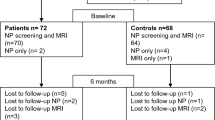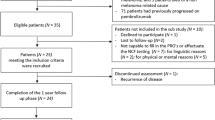Abstract
The prognosis and impact of residual symptoms on quality of life in patients with Lyme neuroborreliosis (LNB) is subject to debate. The aim of this study was to assess quality of life, fatigue, depression, cognitive impairment and verbal learning in patients with definite LNB and healthy controls in a case–control study. We retrospectively identified all patients diagnosed with definite LNB between 2003 and 2014 in our tertiary care center. Healthy controls were recruited from the same area. Patients and healthy controls were assessed for quality of life [Short Form (36) with subscores for physical and mental components (PCS, MCS)], fatigue (fatigue severity scale), depression (Beck depression inventory), verbal memory and learning and cognitive impairment (mini-mental state examination). 53 patients with definite LNB could be identified, of which 30 partook in the follow-up assessment. Estimates for quality of life, fatigue, depression, verbal memory and cognitive impairment did not differ statistically significantly between 30 patients with LNB and 35 healthy controls. Patients with residual symptoms had lower scores for quality of life (PCS) compared to patients without residual symptoms. Our results do not support the hypothesis that a considerable proportion of patients with antibiotically treated LNB develop a ‘post Lyme syndrome’ consisting of debilitating fatigue or cognitive impairment or have severe limitations of quality of life. However, some patients experience residual symptoms of LNB.
Similar content being viewed by others
References
Huppertz HI, Bohme M, Standaert SM, Karch H, Plotkin SA (1999) Incidence of Lyme borreliosis in the Wurzburg region of Germany. Eur J Clin Microbiol 18(10):697–703
Berglund J, Stjernberg L, Ornstein K, Tykesson-Joelsson K, Walter H (2002) 5-y Follow-up study of patients with neuroborreliosis. Scand J Infect Dis 34(6):421–425
Kaiser R (1998) Neuroborreliosis. J Neurol 245(5):247–255
Pfister HW, Einhaupl KM, Wilske B, Preac-Mursic V (1987) Bannwarth’s syndrome and the enlarged neurological spectrum of arthropod-borne borreliosis. Zentralblatt fur Bakteriologie, Mikrobiologie, und Hygiene Series A 263(3):343–347
Kaiser R (2004) Clinical courses of acute and chronic neuroborreliosis following treatment with ceftriaxone. Nervenarzt 75(6):553–557
Mygland A, Ljostad U, Fingerle V, Rupprecht T, Schmutzhard E, Steiner I et al (2010) EFNS guidelines on the diagnosis and management of European Lyme neuroborreliosis. Eur J Neurol 17(1):8–16, e1–4
Wormser GP, Dattwyler RJ, Shapiro ED, Halperin JJ, Steere AC, Klempner MS et al (2006) The clinical assessment, treatment, and prevention of lyme disease, human granulocytic anaplasmosis, and babesiosis: clinical practice guidelines by the Infectious Diseases Society of America. Clin Infect Dis 43(9):1089–1134
Cameron D, Gaito A, Harris N, Bach G, Bellovin S, Bock K et al (2004) Evidence-based guidelines for the management of Lyme disease. Expert Rev Anti-infect Ther 2(1 Suppl):S1–S13
Patel R, Grogg KL, Edwards WD, Wright AJ, Schwenk NM (2000) Death from inappropriate therapy for Lyme disease. Clin Infect Dis 31(4):1107–1109
Holzbauer SM, Kemperman MM, Lynfield R (2010) Death due to community-associated Clostridium difficile in a woman receiving prolonged antibiotic therapy for suspected lyme disease. Clin Infect Dis 51(3):369–370
Auwaerter PG, Bakken JS, Dattwyler RJ, Dumler JS, Halperin JJ, McSweegan E et al (2011) Antiscience and ethical concerns associated with advocacy of Lyme disease. Lancet Infect Dis 11(9):713–719
Cerar D, Cerar T, Ruzic-Sabljic E, Wormser GP, Strle F (2010) Subjective symptoms after treatment of early Lyme disease. Am J Med 123(1):79–86
Kalish RA, Kaplan RF, Taylor E, Jones-Woodward L, Workman K, Steere AC (2001) Evaluation of study patients with Lyme disease, 10–20-year follow-up. J Infect Dis 183(3):453–460
Skogman BH, Croner S, Nordwall M, Eknefelt M, Ernerudh J, Forsberg P (2008) Lyme neuroborreliosis in children: a prospective study of clinical features, prognosis, and outcome. Pediatr Infect Dis J 27(12):1089–1094
Eikeland R, Mygland A, Herlofson K, Ljostad U (2011) European neuroborreliosis: quality of life 30 months after treatment. Acta Neurol Scand 124(5):349–354
Benke T, Gasse T, Hittmair-Delazer M, Schmutzhard E (1995) Lyme encephalopathy: long-term neuropsychological deficits years after acute neuroborreliosis. Acta Neurol Scand 91(5):353–357
Rabin R, de Charro F (2001) EQ-5D: a measure of health status from the EuroQol Group. Ann Med 33(5):337–343
Krupp LB, LaRocca NG, Muir-Nash J, Steinberg AD (1989) The fatigue severity scale. Application to patients with multiple sclerosis and systemic lupus erythematosus. Arch Neurol 46(10):1121–1123
Helmstaedter C, Lendt M, Lux S (2001) Verbaler Lern- und Merkfähigkeitstest: VLMT. Beltz Test, Göttingen
Ljostad U, Skogvoll E, Eikeland R, Midgard R, Skarpaas T, Berg A et al (2008) Oral doxycycline versus intravenous ceftriaxone for European Lyme neuroborreliosis: a multicentre, non-inferiority, double-blind, randomised trial. Lancet Neurol 7(8):690–695
Schulz KF, Grimes DA (2002) Case–control studies: research in reverse. Lancet 359(9304):431–434
Eikeland R, Ljostad U, Mygland A, Herlofson K, Lohaugen GC (2012) European neuroborreliosis: neuropsychological findings 30 months post-treatment. Eur J Neurol 19(3):480–487
Author information
Authors and Affiliations
Corresponding author
Ethics declarations
Conflicts of interest
RD, AS, MM, TH and AB have nothing to declare. SR reports receiving consulting and lecture fees, grant and research support from Bayer Vital GmbH, Biogen Idec, Merck Serono, Novartis, Sanofi-Aventis, Baxter, RG, and Teva. Furthermore, SR indicates that he is a founding executive board member of ravo Diagnostika GmbH. All other authors declare that they have no competing interests. OS reports receiving consulting and lecture fees, grant and research support from Baxter, Bayer Vital GmbH, Biogen Idec, Genzyme, Merck Serono, Novartis, RG, Sanofi-Aventis and Teva.
Ethical standard
The study was approved by the ethics committee of the Medical Center, University of Freiburg. Informed consent was obtained from every participant.
Rights and permissions
About this article
Cite this article
Dersch, R., Sarnes, A.A., Maul, M. et al. Quality of life, fatigue, depression and cognitive impairment in Lyme neuroborreliosis. J Neurol 262, 2572–2577 (2015). https://doi.org/10.1007/s00415-015-7891-4
Received:
Revised:
Accepted:
Published:
Issue Date:
DOI: https://doi.org/10.1007/s00415-015-7891-4




